THE KENT COAST: OLD ENGLAND MEETS NEW LONDON AT THE SEASIDE
CINQUE PORTS, VINTAGE SOUL, CONTEMPORARY ART, DFLs & F&C
On a clear day you can see forever (well, to France) - Deal’s pebble beach and modernist pier.
I spent the past weekend on the coast of Kent – the English county that faces France – unintentionally finding myself there to celebrate the arrival of spring. Good timing as the weather was delicious (if chilly at night).
I started in Deal, visited Ramsgate and finished in Margate, three historic “cinque port” seaside towns forever linked by coast and history. The cinque ports were a network of seaside towns that came together as a loose defensive bulwark against the French almost a thousand years ago. Back then Sandwich, now a tiny town packed with historic buildings, oversaw things – that is until the town’s harbour silted up, ending Sandwich’s reign. Later on a certain Earl who, unintentionally, created a lunchtime snack due to not wanting to be distracted by a meal whilst gambling, would take the pretty (if now isolated) town to incredible prominence.
I know this region well after years of visiting and cycle touring – being around 90 minutes train ride from London make the Kentish coast easy to access and, ever since my friends Gary and Jane left London for Birchington On Sea at the start of the new millennium, I’ve dropped by. Watching the remarkable reinvention of Deal, Ramsgate and (especially) Margate has been a lesson in how quickly communities can change – 25 years ago Margate was afflicted with ruination of the kind that blights left behind settlements, now its a visitor hotspot with chic outposts alongside the traditional British seaside attractions. Ramsgate is also undergoing rapid redevelopment, while Deal, the smallest of the three, has awoken after a long doze.
Ramsgate’s main beach - in summer it would be rammed. The new apartments with the circular balconies have been built not for locals but those who invest in air b&bs…
Margate and Ramsgate both developed into popular holiday towns for Londoners in the 18th and 19th Centuries, then experienced rapid decline after cheap holidays in Spain and Portugal became available at the start of the 1970s. What brought Londoners back was, initially, the spiralling cost of housing in London – after Brighton’s accommodation prices caught up with London, people looked into Kent: Margate and Ramsgate are large enough to house supermarkets (Ramsgate even has a Waitrose) and other urban amenities - alongside direct rail links with London - so ensuring people began resettling here. From shabby seaside towns largely populated with pensioners to desirable residencies for aspirational London families, the Kent coast is rapidly reinventing itself.
The 20 11 opening of the Turner Contemporary art gallery in Margate, twinned with the expansive fame surrounding Tracey Emin - the abrasive contemporary YBA (Young British Artist) who hails from Margate and has, in recent years, invested in building art spaces here – brought visitors. As did the re-opening of Dreamland, an old fashioned fun fair by the sea (which now hosts regular music events across the summer - soul, indie, ska, country festivals are all now part of Margate’s summer). Joseph Turner, the celebrated British land and seascape painter, loved to paint Margate while Vincent Van Gogh lived and taught briefly in Ramsgate. Which is to say, this coast has always attracted artists.
At present the Turner Contemporary features Resistance, a large collection of b&w photos featuring people protesting across Britain and taken from the suffragettes in 1922 through to the poll tax uprising (some 35 years ago today, as I write). Why it stops then, I don’t know – perhaps b&w photography as employed by photo journalists ended in the early 80s?
Photo featured in Resistance documenting a protest following the murder of Kelso Cochrane by a gang of white youths in Notting Hill in 1959.
Resistance is curated by Steve McQueen, the British video artist turned film director, and its theme is the constant struggle ordinary people have engaged in to fight the power. Why a celebration of photo-journalism is in a contemporary art gallery, I’m unsure – especially seeing McQueen’s video art has always been conceptual (and essentially apolitical) in execution. No matter, entry is free, the building is striking (great views out across the channel) and the images so strong – constant struggle - they linger long after you have left the exhibition.
Today Margate is often referred to as “Shoreditch on sea” – further up the coast, the pretty fishing town of Whitstable has long been known as “Islington on sea” – and in Margate the culture clash is evident: wealthy Londoners who own second homes are serviced by pricey restaurants and artisan cafes, while the settled working class community frequent scruffy pubs (there’s even a skinhead pub tucked away on a back street), greasy spoon cafes and discount supermarkets. I’m unaware of any physical clashes but there are tensions: Thanet (the local government district Margate’s part of) often attracts large numbers of votes for anti-immigrant political parties - initially these were anti migrants from the EU – now they’re also anti the London elite. And the Brexit referendum won a majority of votes across Kent.
The Flamingo: plenty of seaside arcade entertainment available inside - old Margate clings on.
While Margate’s attracted more DFLs (Down From London) than the other Kentish seaside towns, the DFLs are evident everywhere: not just wealthy second home owners, many have resettled on the coast because they’ve been priced out of London - in Deal I’ve two sets of friends who arrived separately (and unaware of each other) from South East London, priced out of raising their children in Camberwell and New Cross, neighbourhoods that were, for decades, considered amongst the least desirable. My pal Mike arrived in Walmer (the town west of Deal) last year after a divorce forced him out of East Dulwich (where he’d lived all his life). One set of friends – Geoff & Diane – continue to commute to London for work (no equivalent jobs on the coast). That’s a real grind, but they don’t regret the shift.
Which is understandable, as Deal is gorgeous. Once a raucous smugglers town with its narrow warren of streets and pebble beach, Deal was long a fishing town before becoming a sleepy retirement community. Until the Londoners (and, admittedly, from further beyond) arrived. Now its begun to get its groove back with plentiful cafes and live music, night time activities and three record shops – the first and best remains Smugglers Records (which also serves ales – perfect - and is connected to the boutique Smugglers Festival, held outside Deal every summer). I always find something in Smugglers and, this time, it was a handful of R&B 45s: Ike & Tina, Etta James, James Brown, Charles Wright, Jerry Butler. Kentish soul? Something like that.
It’s not often I’ll post a photo from a football match so anyone who is sports mad should appreciate this one.
Recent arrival Mike has shifted his football loyalty from Milwall to Deal Town – they’re a non-league team and, visiting Mike, ensures I’ve now seen them play twice. Which means I’ve doubled the number of football matches I’ve been to in my time in the UK. Watching Deal Town beat Three Bridges 3-0 on Saturday was enjoyable, if not something I need often do. £6 entry – affordable football!
Ramsgate has a gorgeous harbour setting, the Music Hall (regularly voted one of the UK’s best small venues), two decent swimming beaches and lots of other stuff (what? Ummm, a Waitrose, the largest Wetherspoons in the UK, a couple of record shops...). I don’t know Ramsgate well but, illuminated by Sunday’s sunshine, it gave off the ambience of a merry seaside town, a mini-Margate. My friend Sharon has lived there for a decade and thinks Ramsgate a wonderful place – I will return to experience more.
Between Ramsgate and Margate there’s Broadstairs, which is very pretty and rather posh. While west of Deal – once you’ve got past the transport/ferry hub of Dover – there’s Folkestone, where I attended Skabour festival last summer. Folkestone’s gritty – as you might imagine is a town that hosts a festival dedicated to ska loving skinheads – yet its historic centre is rapidly developing (alongside a Margate-inspired sculpture trail).
The Kentish coast may be opening up to new residents - and is surely surprised to find contemporary art powering part of its transformation - but, I’ll note, it remains traditionally English ie very white. The cinque ports lack the diversity and excitement of Britain’s cities. Things are changing – my aforementioned friends are in mixed relationships and have raised their mixed race kids here without problems – but the arrival of large numbers of illegal migrants from France on the western Kent coastline (via small boats) continues to fuel sympathies for far-right political parties.
This aside, for the most part, coastal Kent is a delight: sit on the beach, cycle the paths, drink ale in ancient pubs, eat fish and chips (Margate has Peter’s Fish Factory, an extremely good value chippie: £5.95 for f&c), see contemporary art, maybe find an old record (or see a band – likely oldies) and just relax.
Fish supper. I ate it all - unbelievable, I know.
Time for a tune?
As I can’t think of any well known musicians who hail from the cinque ports, I’ve decided Londoners’ Chas & Dave’s celebration of the working class coach outing to Margate is fitting here. Chas Hodges and Dave Peacock created a good natured party music that mixed Cockney pub sing-around-the-piano with early rock’n’roll - essentially, the sounds that shaped their youths. The duo’s songs were simple but they were superb musicians who earned a living for years playing sessions (that’s C&D playing the rhythmic hook Dr Dre sampled for Eminem’s My Name Is) before achieving a degree of fame as Chas & Dave. This jolly knees-up later featured on an episode of the sitcom Only Fools & Horses, which involved Peckham’s finest on a coach trip to – you guessed it – Margate.
I interviewed Chas not too long before he died in 2018. He was a lovely chap to chat with – if anyone’s interested do let me know and I’ll try and find my feature.
Margate low tide. I know what you’re thinking: ‘doesn’t look very chic to me!’

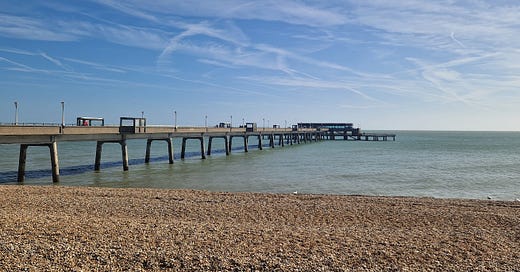




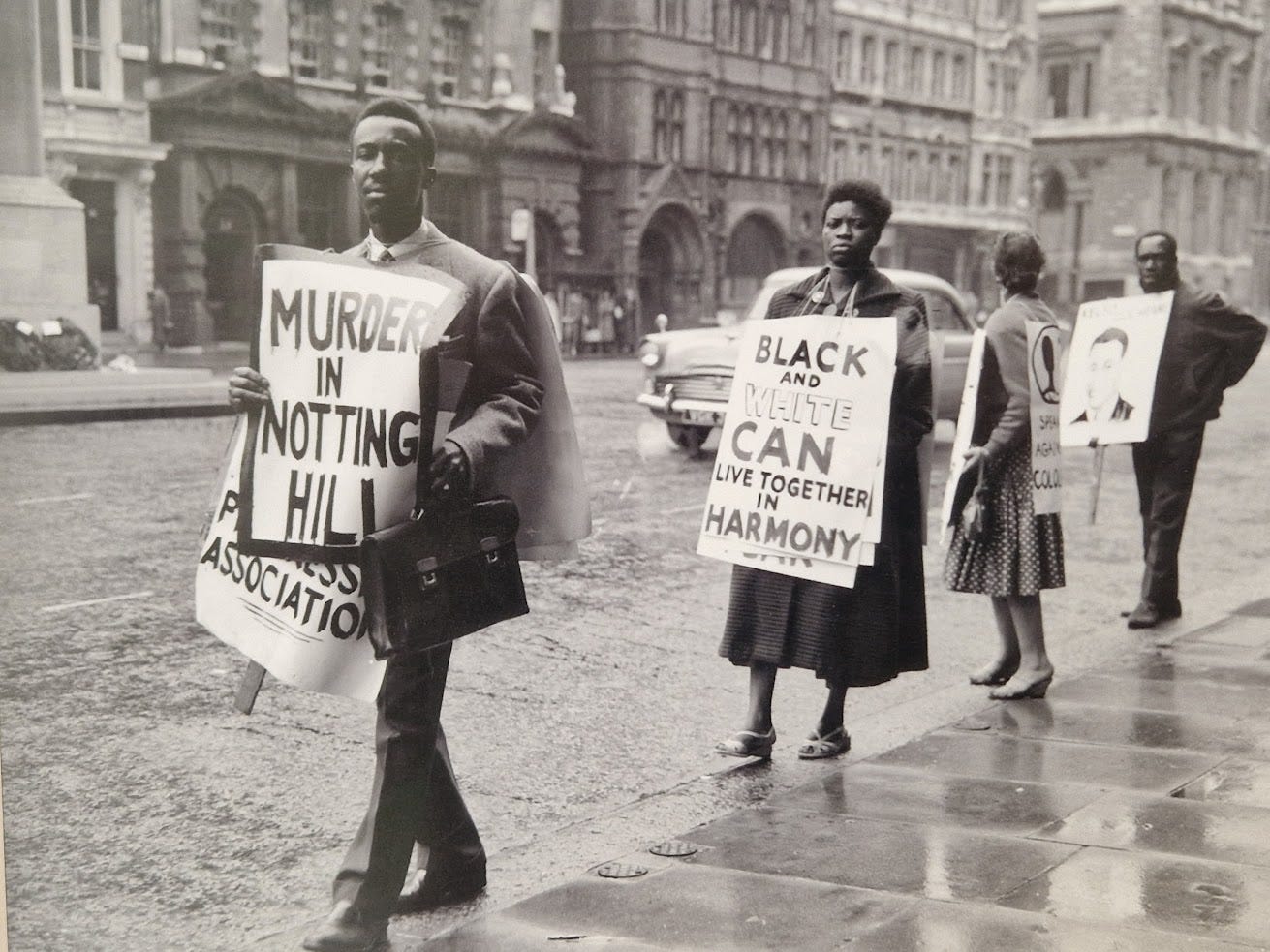

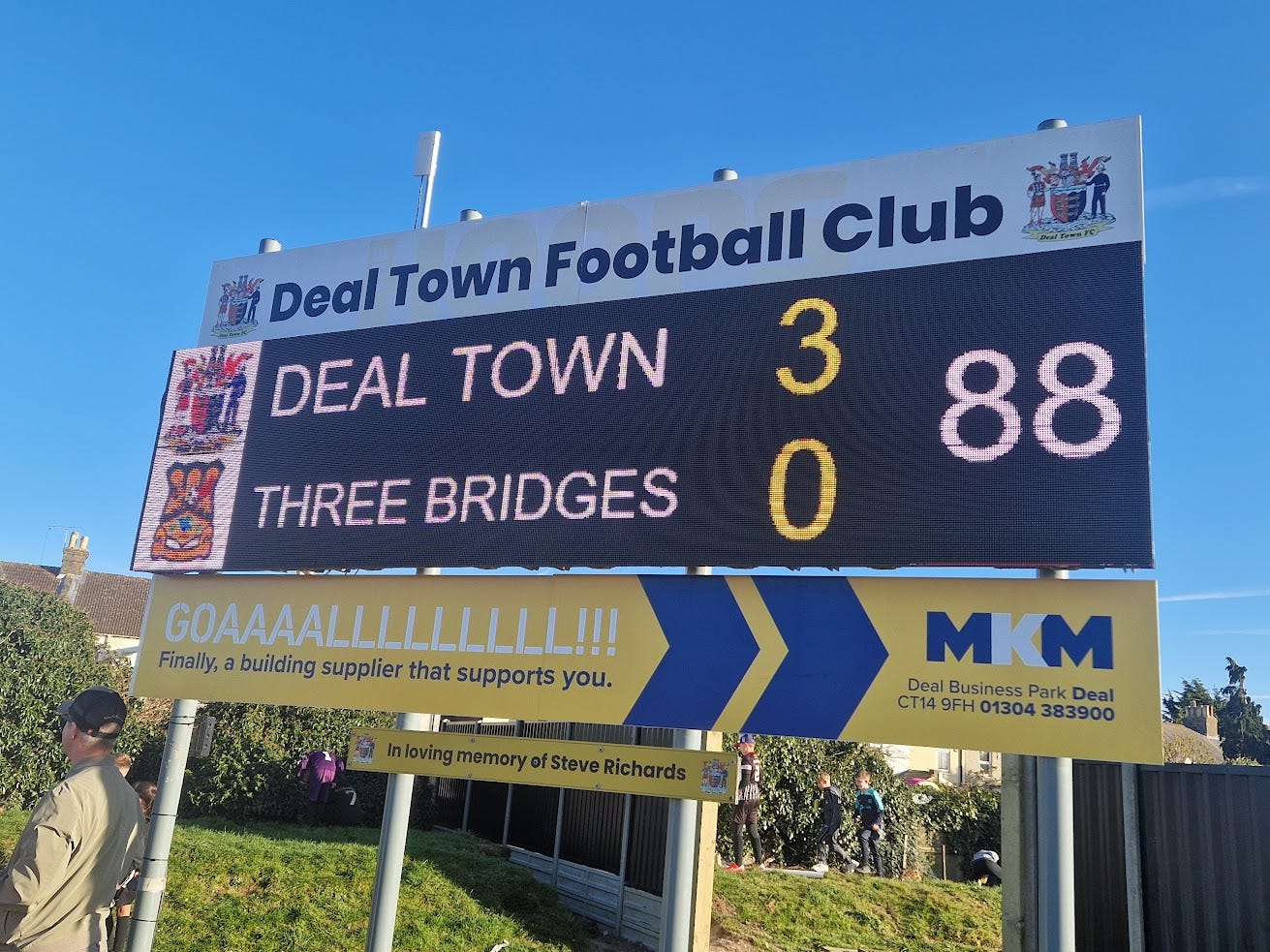
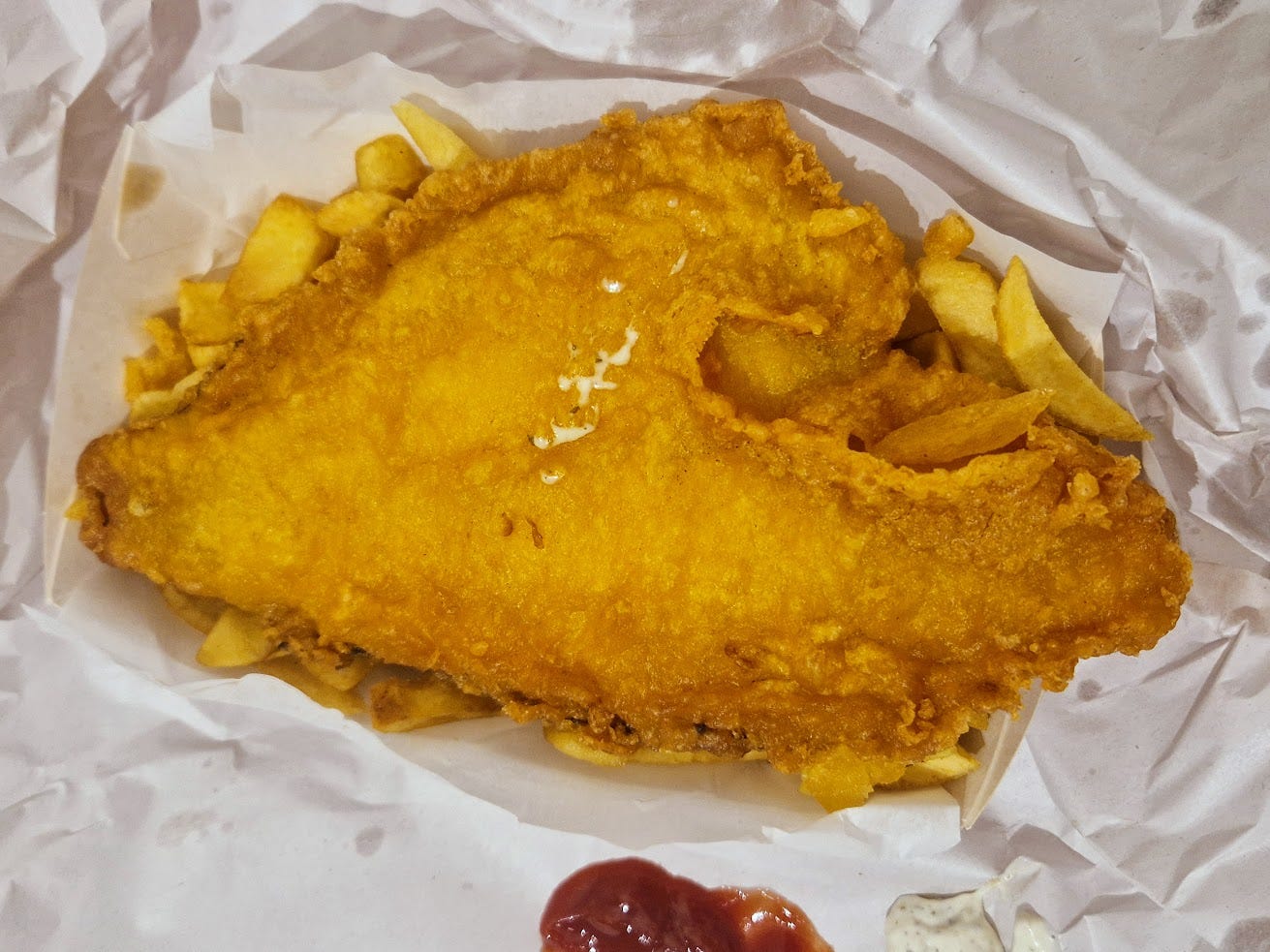
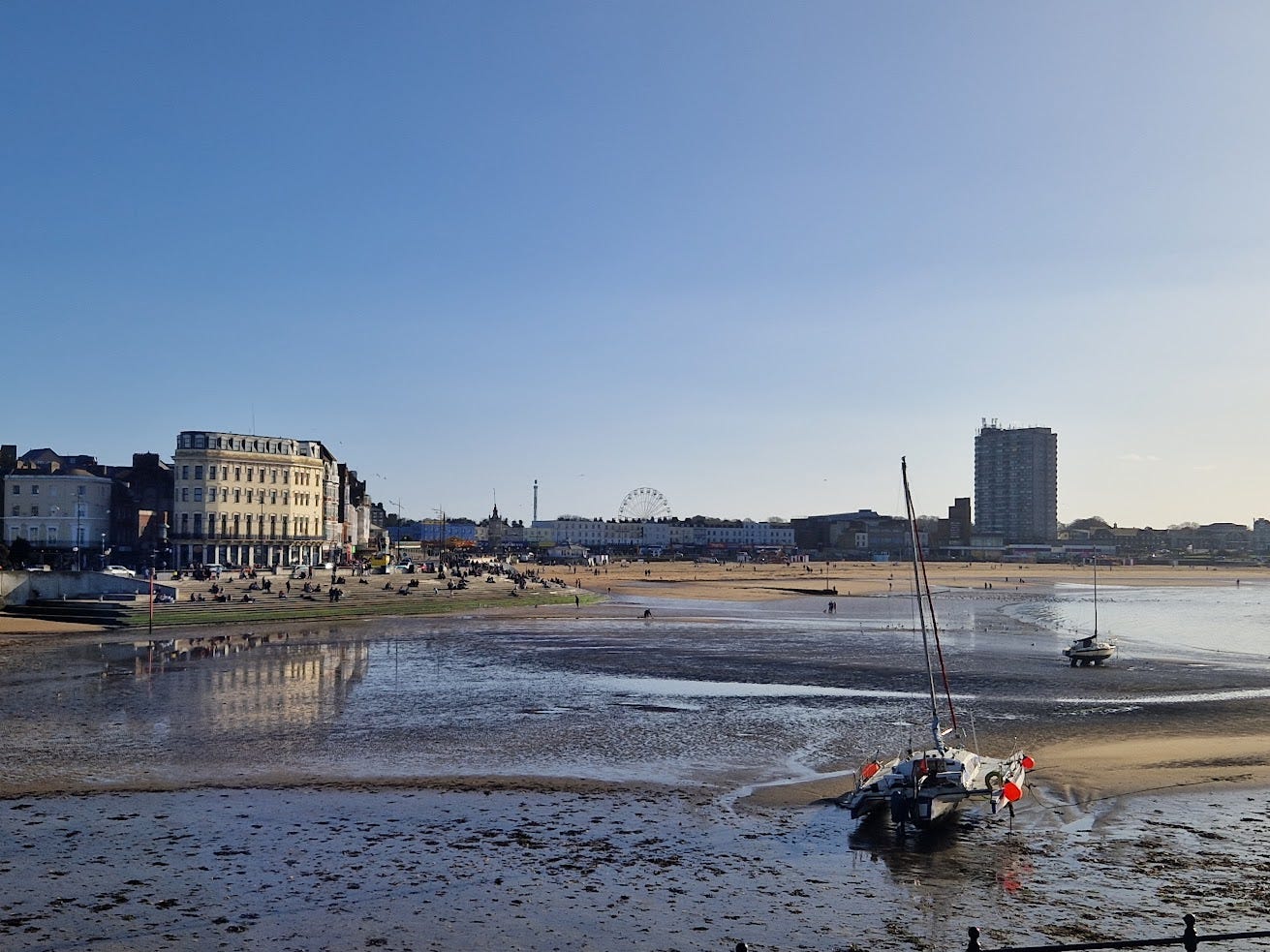
Over the last few years we've really discovered and grown to love the south-east coast, although curiously of all the places you mention we've only been to Sandwich and Broadstairs (it has a good folk festival, and I've already put it in the diary for this year to try to see Flook). Favourites of ours (stretching beyond the Kent coast) are Whitstable, Hythe, Dungeness, Tilling and Hastings.
I would like to read your Chas & Dave article. Sadly I never managed to see them perform before the latter's death. I think I read that Dave is now performing with Chas's daughter.
Chris